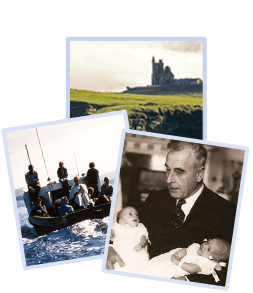| 1694 |
10,000 acres of land in Sligo comes into the possession of Sir John Temple of East Sheen, Attorney General of Ireland |
| 1704 |
Sir John Temple dies, his son Henry inherits his estate |
| 1723 |
Henry Temple is created the first Viscount Palmerston of Palmerston in County Dublin |
| 1757 |
1st Viscount Palmerston dies and is succeeded by his grandson |
| 1802 |
2nd Viscount Palmerston dies and is suceeded by his son, Henry John Temple the 3rd Viscount Palmerston. |
| 1808 |
3rd Viscount also known as Lord Palmerston visits his Sligo estates for the first time and plans improvements in Mullaghmore and its harbour |
| 1822 |
Building begins at Mullaghmore harbour. The project, designed by Alexander Nimmo, is funded by Lord Palmerston and government grants |
| 1827 |
Short pier and jetty at the northern end of Mullaghmore harbour is completed |
| 1828 |
Harbour is officially opened and plots of land in the vicinity are available for warehouse sites |
| 1841 |
Mr Kincaid, Lord Palmerston’s Sligo agent, is concerned at progress of harbour extension. It is costing £500 per month. |
| 1842 |
Extension to Mullaghmore Harbour is completed |
| 1847 |
Carrick of Whitehaven, the first of nine ships carrying émigré tenants from Lord Palmerston’s Sligo estates, sinks off the Canadian coast. |
| 1855 |
Lord Palmerston becomes British Prime Minister |
| 1859 |
Lord Palmerston becomes British Prime Minister for the second time |
| 1865 |
Lord Palmerston dies. His holiday home, Classiebawn Castle at Mullaghmore, is inherited by his stepson, William Cowper-Temple, later 1st Baron Mount Temple of Mount Temple |
| 1874 |
Classiebawn Castle, designed by the architect, J Rawson Carroll, is completed |
| 1888 |
William Cowper-Temple, 1st Baron Mount Temple, dies. Classiebawn inherited by his nephew, the Rt. Hon. Evelyn Ashley |
| 1889 |
Rt Hon Evelyn Ashley discusses transfering Mullaghmore harbour to the Board of Works in Dublin |
| 1907 |
Rt. Hon. Evelyn Ashley dies. Classiebawn inherited by his son, Lt. Col. Wilfrid Ashley, later 1st Baron Mount Temple of Lee, Southampton |
| 1916 |
The Castle is commandeered by the Irish Free State Army |
| 1918 |
During the ‘Cliffoney Land Fight’, five local IRA men are convicted of unlawful assembly for ploughing and cultivating Lt. Col. Ashley’s grazing land |
| 1920 |
Top level IRA plans to destroy Classiebawn are aborted in the face of vehement opposition by local active IRA members |
| 1920 |
Letter to Lt. Col. Ashley is seized by Sein Feiners, endorsed with “passed I.R. censor” and delivered |
| 1921 |
Rt. Hon. Lt. Col. Ashley MP asks the British Prime Minister for protection of Classiebawn. Later reports of ‘destruction’ to the Castle |
| 1922 |
IRA hold three hostages at Classiebawn in response to three IRA volunteers imprisoned in Derry under sentence of death. |
| 1922 |
Marriage of Lord Louis Mountbatten and Edwina Ashley, elder daughter of Rt. Hon. Lt. Col. Wilfrid Ashley MP |
| 1922 |
Rt. Hon. Lt. Col. Ashley MP closes up Classiebawn |
| 1923 |
Local Republican volunteers are detained in Classiebawn by Freestate Army pending transfer to Finner Camp in County Donegal |
| 1925 |
Rt. Hon. Lt. Col. Ashley ‘mothballs’ Classiebawn and arranges distribution of its contents |
| 1939 |
Lt. Col. Ashley dies. His daughter, Edwina Mountbatten, inherits Classiebawn |
| 1943 |
Edwina Mountbatten visits Classiebawn |
| 1945 |
Edwina Mountbatten starts a programme of renovations |
| 1947 |
Edwina Mountbatten and her family visit Classiebawn; renovations are underway |
| 1948 |
A generator is installed providing light and power |
| 1949 |
Renovations are complete |
| 1954 |
Edwina Mountbatten appeals to the Irish Government for aid after flooding of the peat bog. She encourages cutting of estate bushes for fuel |
| 1960 |
Edwina Mountbatten dies. Her husband, Lord Mountbatten (Louis), inherits Classiebawn. |
| 1960 |
Shadow V is built at McCanns’ boatyard in Moneygold from timber felled in Classiebawn Woods. She is delivered to Mullaghmore for sea trials |
| 1960 |
Unsubstantiated report in UK’s Daily Express alleging a threat from the IRA for flying the Union Jack at Classiebawn |
| 1961 |
Lord Mountbatten offers Classiebawn Wood to the Minister for Lands, Irish Government |
| 1961 |
Classiebawn is let to summer visitors |
| 1962 |
Lord Mountbatten writes two Guide Books to Classiebawn and surrounding area. |
| 1965 |
Shadow V is suspiciously holed and sinks in Mullaghmore Harbour |
| 1965 |
Mains water is piped to the castle |
| 1967 |
At the request of Lord Mountbatten the cabin of Shadow V is rebuilt |
| 1971 |
Garda security for Lord Mountbatten’s visit is increased from 8 to 12 in view of internment being introduced in Northern Ireland, 3 on duty all the time |
| 1973 |
Garda security for visit of Lord Mountbatten and his family is increased to 15 |
| 1974 |
Garda security for visit of Lord Mountbatten and his family is increased to 24 |
| 1975 |
Lord Mountbatten offers Classiebawn to the Irish State, rent free. The Taoiseach, Liam Cosgrave, refuses. |
| 1976 |
Irish businessman, Hugh Tunney, leases Classiebawn |
| 1979 |
Lord Mountbatten, Nicholas Knatchbull & Paul Maxwell die aboard Shadow V. Doreen, The Dowager Lady Brabourne dies in Sligo Hospital the following day. |
| 1979 |
Thomas McMahon is convicted of the murder of Lord Mountbatten |
| 1981 |
Provisional Sinn Fein protestors hang a banner and the Irish tricolour from a window at Classiebawn in support of Republican hunger strikers |
| 1992 |
Body of Margaret Perry is found in woods close to Classiebawn. She was murdered in 1991 by her associates who were IRA and Special Branch informers |
| 1995 |
Incendiary device is discovered at the front door of Classiebawn. It preceeds a visit by Prince Charles to the Republic the next day |
| 1998 |
Thomas McMahon, convicted of the murder of Lord Mountbatten, is released from prison under terms of the ‘Good Friday’ Agreement |
| 2004 |
Local residents hold a ceremony at Classiebawn’s gates to commemorate the events of 1979 |




